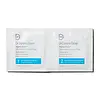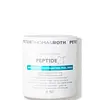What's inside
What's inside
 Key Ingredients
Key Ingredients

 Benefits
Benefits

 Concerns
Concerns

 Ingredients Side-by-side
Ingredients Side-by-side

Water
Skin ConditioningHamamelis Virginiana Water
AstringentPolysorbate 20
EmulsifyingLactic Acid
BufferingMandelic Acid
AntimicrobialSalix Alba Bark Extract
AstringentCamellia Sinensis Leaf Extract
AntimicrobialAchillea Millefolium Extract
CleansingAnthemis Nobilis Flower Extract
MaskingChamomilla Recutita Flower Extract
MaskingSaccharum Officinarum Extract
MoisturisingCitrus Aurantium Dulcis Fruit Extract
MaskingCitrus Limon Fruit Extract
MaskingGlycerin
HumectantSoy Isoflavones
Skin ConditioningCopper PCA
HumectantZinc PCA
HumectantPotassium Hydroxide
BufferingDisodium EDTA
Citric Acid
BufferingCaprylic/Capric Triglyceride
MaskingCucumis Sativus Fruit Extract
EmollientCitrus Limon Peel Extract
EmollientRose Extract
Skin ConditioningTriethyl Citrate
MaskingPyrus Malus Fruit Extract
Skin ConditioningCoriandrum Sativum Fruit/Leaf Extract
AntiseborrhoeicFucus Vesiculosus Extract
EmollientJasminum Officinale Flower/Leaf Extract
MaskingPrunus Persica Fruit Extract
AbrasiveRosmarinus Officinalis Leaf Extract
AntimicrobialRubus Idaeus Fruit Extract
AstringentVaccinium Macrocarpon Fruit Extract
AstringentVanilla Planifolia Fruit Extract
Skin ConditioningCitrus Aurantium Bergamia Fruit Extract
Skin ConditioningLavandula Angustifolia Flower/Leaf/Stem Extract
MaskingBenzoic Acid
MaskingPhenoxyethanol
PreservativeSodium Benzoate
MaskingSodium Bicarbonate
AbrasiveSodium Hyaluronate
HumectantColloidal Oatmeal
AbsorbentCentella Asiatica Extract
CleansingPhospholipids
Skin ConditioningAdenosine
Skin ConditioningResveratrol
AntioxidantUbiquinone
AntioxidantLeuconostoc/Radish Root Ferment Filtrate
AntimicrobialSodium PCA
HumectantButylene Glycol
HumectantOctoxynol-9
EmulsifyingTetrasodium EDTA
Potassium Sorbate
PreservativeWater, Hamamelis Virginiana Water, Polysorbate 20, Lactic Acid, Mandelic Acid, Salix Alba Bark Extract, Camellia Sinensis Leaf Extract, Achillea Millefolium Extract, Anthemis Nobilis Flower Extract, Chamomilla Recutita Flower Extract, Saccharum Officinarum Extract, Citrus Aurantium Dulcis Fruit Extract, Citrus Limon Fruit Extract, Glycerin, Soy Isoflavones, Copper PCA, Zinc PCA, Potassium Hydroxide, Disodium EDTA, Citric Acid, Caprylic/Capric Triglyceride, Cucumis Sativus Fruit Extract, Citrus Limon Peel Extract, Rose Extract, Triethyl Citrate, Pyrus Malus Fruit Extract, Coriandrum Sativum Fruit/Leaf Extract, Fucus Vesiculosus Extract, Jasminum Officinale Flower/Leaf Extract, Prunus Persica Fruit Extract, Rosmarinus Officinalis Leaf Extract, Rubus Idaeus Fruit Extract, Vaccinium Macrocarpon Fruit Extract, Vanilla Planifolia Fruit Extract, Citrus Aurantium Bergamia Fruit Extract, Lavandula Angustifolia Flower/Leaf/Stem Extract, Benzoic Acid, Phenoxyethanol, Sodium Benzoate, Sodium Bicarbonate, Sodium Hyaluronate, Colloidal Oatmeal, Centella Asiatica Extract, Phospholipids, Adenosine, Resveratrol, Ubiquinone, Leuconostoc/Radish Root Ferment Filtrate, Sodium PCA, Butylene Glycol, Octoxynol-9, Tetrasodium EDTA, Potassium Sorbate
Oat Amino Acids
Skin ConditioningRetinol
Skin ConditioningWater
Skin ConditioningButylene Glycol
HumectantSodium Lactate
BufferingPhytic Acid
PPG-5-Ceteth-20
EmulsifyingRosa Centifolia Flower Water
Skin ConditioningHamamelis Virginiana Water
AstringentSalicylic Acid
MaskingThreonine
Glutamic Acid
HumectantSerine
MaskingAspartic Acid
MaskingArginine
MaskingAlanine
MaskingProline
Skin ConditioningValine
MaskingHistidine
HumectantGlycine
BufferingLysine
Skin ConditioningChamomilla Recutita Flower Extract
MaskingCamellia Sinensis Leaf Extract
AntimicrobialAscorbic Acid
AntioxidantRetinyl Palmitate
Skin ConditioningTocopheryl Acetate
AntioxidantAloe Barbadensis Leaf Juice
Skin ConditioningBorago Officinalis Seed Oil
EmollientSymphytum Officinale Leaf Extract
Skin ConditioningCitrus Limon Peel Extract
EmollientCitrus Aurantifolia Peel Extract
CleansingCitrus Aurantium Dulcis Fruit Extract
MaskingCitrus Tangerina Peel Extract
AstringentMentha Piperita Extract
CleansingSalvia Officinalis Leaf Extract
CleansingZingiber Officinale Root Extract
MaskingPhenoxyethanol
PreservativeSodium Hydroxide
BufferingAminobutyric Acid
Potassium Sorbate
PreservativeSodium Benzoate
MaskingCaprylic/Capric Triglyceride
MaskingPEG-8 Dimethicone
EmulsifyingLeucine
Skin ConditioningSodium Ascorbyl Phosphate
AntioxidantLimonene
PerfumingBenzoic Acid
MaskingTyrosine
MaskingPhenylalanine
MaskingIsoleucine
Skin ConditioningCitric Acid
BufferingOctyldodecanol
EmollientSilica
AbrasiveSodium Propoxyhydroxypropyl Thiosulfate Silica
Oat Amino Acids, Retinol, Water, Butylene Glycol, Sodium Lactate, Phytic Acid, PPG-5-Ceteth-20, Rosa Centifolia Flower Water, Hamamelis Virginiana Water, Salicylic Acid, Threonine, Glutamic Acid, Serine, Aspartic Acid, Arginine, Alanine, Proline, Valine, Histidine, Glycine, Lysine, Chamomilla Recutita Flower Extract, Camellia Sinensis Leaf Extract, Ascorbic Acid, Retinyl Palmitate, Tocopheryl Acetate, Aloe Barbadensis Leaf Juice, Borago Officinalis Seed Oil, Symphytum Officinale Leaf Extract, Citrus Limon Peel Extract, Citrus Aurantifolia Peel Extract, Citrus Aurantium Dulcis Fruit Extract, Citrus Tangerina Peel Extract, Mentha Piperita Extract, Salvia Officinalis Leaf Extract, Zingiber Officinale Root Extract, Phenoxyethanol, Sodium Hydroxide, Aminobutyric Acid, Potassium Sorbate, Sodium Benzoate, Caprylic/Capric Triglyceride, PEG-8 Dimethicone, Leucine, Sodium Ascorbyl Phosphate, Limonene, Benzoic Acid, Tyrosine, Phenylalanine, Isoleucine, Citric Acid, Octyldodecanol, Silica, Sodium Propoxyhydroxypropyl Thiosulfate Silica
 Reviews
Reviews

Alternatives
Ingredients Explained
These ingredients are found in both products.
Ingredients higher up in an ingredient list are typically present in a larger amount.
Benzoic Acid is used to preserve and adjust the pH of products.
The antimicrobial property of Benzoic Acid helps elongate a product's shelf life. Its main role is to reduce fungi growth and is not found to be effective at fighting bacteria. Therefore Benzoic Acid is always added along with other preservatives.
In its pure form, Benzoic Acid looks like a white crystalline solid. It has slight solubility in water.
The name of Benzoic Acid comes from gum benzoin, which used to be the sole source of deriving this ingredient. Benzoic Acid is the most simple aromatic carboxylic acid.
Benzoic Acid is naturally occuring in strawberries, mustard, cinnamon, and cloves. It has a slight scent but is not considered to be a fragrance.
Learn more about Benzoic AcidButylene Glycol (or BG) is used within cosmetic products for a few different reasons:
Overall, Butylene Glycol is a safe and well-rounded ingredient that works well with other ingredients.
Though this ingredient works well with most skin types, some people with sensitive skin may experience a reaction such as allergic rashes, closed comedones, or itchiness.
Learn more about Butylene GlycolCamellia Sinensis Leaf Extract is derived from the leaves of the tea plant. Black tea, green tea, and oolong tea are all harvested from this plant.
This ingredient has many skin benefits:
This ingredient contains polyphenols, a strong antioxidant. Antioxidants help fight off molecules that damage skin cells.
On top of that, the antioxidants in green tea neutralize free-radicals from the sun. This gives the skin some extra UV protection, but should not replace sunscreen.
Many components of tea have anti-inflammatory properties.
Polyphenols and L-theanine help soothe the skin and reduce irritation. The caffeine in Camellia Sinensis Leaf Extract helps calm inflamed blood vessels.
Other compounds found in tea include: Vitamin Bs, linoleic acid, magnesium, calcium, iron, and zinc.
Research has shown both drinking Camellia Sinensis Leaf Tea and applying it to the skin can help boost skin elasticity and hydration. Studies also show using tea extract may reduce sebum, or oil, production.
Learn more about Camellia Sinensis Leaf ExtractThis ingredient is an emollient, solvent, and texture enhancer. It is considered a skin-softener by helping the skin prevent moisture loss.
It helps thicken a product's formula and makes it easier to spread by dissolving clumping compounds.
Caprylic Triglyceride is made by combining glycerin with coconut oil, forming a clear liquid.
While there is an assumption Caprylic Triglyceride can clog pores due to it being derived from coconut oil, there is no research supporting this.
Learn more about Caprylic/Capric TriglycerideChamomilla Recutita Flower Extract comes from the Chamomile flower.
Chamomile is rich in antioxidants and has anti-inflammatory properties. Several compounds found in chamomile help with soothing, such as bisbolol.
Antioxidant components in chamomile make it an effective ingredient to help slow the signs of aging. Antioxidants help fight free-radical molecules, or molecules that may damage your skin.
Essential oils from chamomile have been found to improve wound healing due to its antimicrobial properties.
Ancient Greeks and Egyptians used Chamomile to treat skin redness and dryness. Chamomile has also been used to help treat stomach issues.
Learn more about Chamomilla Recutita Flower ExtractCitric Acid is an alpha hydroxy acid (AHA) naturally found in citrus fruits like oranges, lemons, and limes.
Like other AHAs, citric acid can exfoliate skin by breaking down the bonds that hold dead skin cells together. This helps reveal smoother and brighter skin underneath.
However, this exfoliating effect only happens at high concentrations (20%) which can be hard to find in cosmetic products.
Due to this, citric acid is usually included in small amounts as a pH adjuster. This helps keep products slightly more acidic and compatible with skin's natural pH.
In skincare formulas, citric acid can:
While it can provide some skin benefits, research shows lactic acid and glycolic acid are generally more effective and less irritating exfoliants.
Most citric acid used in skincare today is made by fermenting sugars (usually from molasses). This synthetic version is identical to the natural citrus form but easier to stabilize and use in formulations.
Read more about some other popular AHA's here:
Learn more about Citric AcidCitrus Aurantium Dulcis Fruit Extract is more commonly known as the bitter orange. Native to Southeast Asia, this extract is commonly found in both cosmetics and foods.
The bitter orange possesses antibacterial and antioxidant properties.
It can also be mildly exfoliating due to the citric acid, an AHA.
Citrus fruits are rich in flavonoids, alkaloids, and vitamin C.
Learn more about Citrus Aurantium Dulcis Fruit ExtractCitrus Limon Peel Extract is created from the peel of a lemon. Lemon peels contain Vitamin C. Lemon peels also exhibit antibacterial, antioxidant, and antifungal properties.
Hamamelis Virginiana Water is made by distilling parts of the witch hazel plant. You can also call this ingredient "witch hazel water".
The name 'Hamamelis Virginiana Water' refers to the distillation product used in cosmetics. On the other hand, 'Witch Hazel' refers to the active drug ingredient.
Unless it is specified to be non-alcohol, many types of witch hazel ingredients are distilled in denatured alcohol.
Witch Hazel water is an astringent, anti-inflammatory antioxidant, and antibacterial ingredient.
It contains tannins. Tannins have a drying effect when used on skin by constricting proteins. The constriction also minimizes the appearance of pores.
Both the tannins and fragrance found in witch hazel may be skin-sensitizing.
Witch hazel water gets anti-inflammatory and antibacterial properties from its catechin and gallic acid content.
Indigenous groups have used witch hazel to help treat inflammation in North America for centuries.
Learn more about Hamamelis Virginiana WaterPhenoxyethanol is a preservative that has germicide, antimicrobial, and aromatic properties. Studies show that phenoxyethanol can prevent microbial growth. By itself, it has a scent that is similar to that of a rose.
It's often used in formulations along with Caprylyl Glycol to preserve the shelf life of products.
Potassium Sorbate is a preservative used to prevent yeast and mold in products. It is commonly found in both cosmetic and food products.
This ingredient comes from potassium salt derived from sorbic acid. Sorbic acid is a natural antibiotic and effective against fungus.
Both potassium sorbate and sorbic acid can be found in baked goods, cheeses, dried meats, dried fruit, ice cream, pickles, wine, yogurt, and more.
You'll often find this ingredient used with other preservatives.
Learn more about Potassium SorbateSodium Benzoate is a preservative. It's used in both cosmetic and food products to inhibit the growth of mold and bacteria. It is typically produced synthetically.
Both the US FDA and EU Health Committee have approved the use of sodium benzoate. In the US, levels of 0.1% (of the total product) are allowed.
Sodium benzoate works as a preservative by inhibiting the growth of bacteria inside of cells. It prevents the cell from fermenting a type of sugar using an enzyme called phosphofructokinase.
It is the salt of benzoic acid. Foods containing sodium benzoate include soda, salad dressings, condiments, fruit juices, wines, and snack foods.
Studies for using ascorbic acid and sodium benzoate in cosmetics are lacking, especially in skincare routines with multiple steps.
We always recommend speaking with a professional, such as a dermatologist, if you have any concerns.
Learn more about Sodium BenzoateWater. It's the most common cosmetic ingredient of all. You'll usually see it at the top of ingredient lists, meaning that it makes up the largest part of the product.
So why is it so popular? Water most often acts as a solvent - this means that it helps dissolve other ingredients into the formulation.
You'll also recognize water as that liquid we all need to stay alive. If you see this, drink a glass of water. Stay hydrated!
Learn more about Water